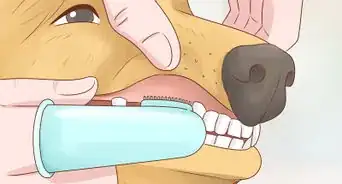This article was co-authored by Pippa Elliott, MRCVS. Dr. Elliott, BVMS, MRCVS is a veterinarian with over 30 years of experience in veterinary surgery and companion animal practice. She graduated from the University of Glasgow in 1987 with a degree in veterinary medicine and surgery. She has worked at the same animal clinic in her hometown for over 20 years.
There are 9 references cited in this article, which can be found at the bottom of the page.
This article has been viewed 101,706 times.
Adopting a dog can be rewarding and exciting, but also challenging. If your dog has unexplained injuries or other physical symptoms, or expresses unusual or extreme behavior, you may wonder if it was abused in the past. While there may not be a definitive way to tell, if you notice physical and behavioral signs of probable abuse, you should take your dog to a veterinarian or animal behaviorist for treatment.
Steps
Checking for Physical Signs of Abuse
-
1Take note of the dog’s general appearance. A dog’s physique will vary widely depending on its breed. However, no dog should appear too thin.[1] For example, if you can clearly see where a dog’s bones are below its skin, it may be emaciated.[2] Since neglected or mistreated dogs are sometimes not adequately fed or are even starved, emaciation can be a sign of prior abuse.
-
2Examine the quality of a dog’s fur. Some dogs have short, stiff hair, others have long, soft hair, while still others fall somewhere in between. Whatever breed a dog is, however, its fur should be clean and free from unexplained clumps or tangles. If your dog has overgrown or matted hair, it may indicate that it has been neglected in the past, not cared for or groomed, or perhaps made to live in substandard conditions.[3]Advertisement
-
3
-
4Notice if the dog’s nails are overgrown. While it may seem like a relatively minor thing, overgrown nails can be a sign that a dog has been abused in the past.[6] This condition can indicate that the dog’s previous owner neglected to care for the animal, or that the dog was kept in conditions in which it could not naturally wear down its nails.
-
5Watch for untreated skin conditions. You should observe a dog’s skin very closely. If you see certain unexplained skin conditions (that is, you don’t know how they came about), these may indicate that the dog was abused physically or did not receive adequate veterinary care in the past. These signs include: [7] [8]
- Scabs
- Wounds
- Bumpy skin
- Scaly skin
- Burns
-
6Be on the lookout for infestations. Dogs that have been abused or neglected may be infested by fleas, ticks, or other parasites.[9] While there are other reasons a dog (even one that is well-cared for) can become a host to one or more of these parasites, a serious, unexplained infestation might indicate mistreatment, especially if there are other signs of possible abuse.
Observing a Dog’s Behavior
-
1Know what kind of behavior to expect. Be careful not to assume that all unusual behavior is a sign of abuse. For instance, dogs that are adjusting to new homes may express certain behaviors (anxiety, excessive chewing, whining, etc.) because they are excited or nervous. Likewise, a dog at a shelter that seems nervous, frightened, or aggressive might not necessarily have been abused.Instead, the dog might not be used to being around so many dogs, or to being confined.
- All dogs need a period of time to be socialized and to adjust to new settings.
- If you are thinking about adopting a dog, try to observe it in a quiet place first. This can give you a better idea of its normal behavior, and help you decide if it is likely to have been abused in the past.
-
2Observe how the dog moves. Sometimes, past abuse can leave no obvious signs on a dog’s skin or fur. However, if you notice lameness or difficulty moving, this can indicate that the dog was injured in the past due to physical abuse.[10] Signs of such a problem can include:
- Unusual gait
- Moving slowly (lethargy)
- Not liking to be touched in certain areas
- Difficulty getting up, laying down, or sitting
- One or more legs moving differently than the others (slower, stiffly, etc.)
-
3Watch for aggressive behavior. Some dogs that have been abused react by becoming aggressive. However, aggressive behavior in dogs can have many other causes, so it is important to talk about your dog’s symptoms with your veterinarian, trainer, or animal behaviorist.[11] Signs of aggressive behavior in dogs include:
- Growling
- Barking
- Snarling
- Baring teeth
- Biting
-
4Look for signs of anxiety. Dogs that have been abused may also react by becoming withdrawn, shy, or fearful. As with aggression, there are many potential causes of anxiety in dogs, so it is important to talk with your veterinarian or another expert to narrow things down.[12] Signs of anxiety in a dog can include:[13]
- Excessive whining
- Excessive panting
- Drooling
- Chewing
- Digging
- Pacing
- Dislike of being left alone or separated
- Urination or defecation when separated from its owners
Doing Research
-
1Know which breeds are likely to have been abused. A dog of any type or gender can be abused. However, breeds that are used for dog fighting and security are more likely to have suffered abuse or neglect. This includes breeds such as pit bulls and Rottweilers[14] Those that abuse these dogs may isolate, starve, and drug them, train them to be extremely aggressive, and cause them to be injured or even die in dogfights.[15]
-
2Contact the dog’s previous owner or caretaker. If you ever have any questions about your dog’s past (such as an unexplained injury or defect), you should feel free to get in touch whoever had the dog before you. Reputable breeders, kennels, animal shelters, and pet stores will all be happy to openly share any information they have.[16] [17] If the previous owner or caretaker does not want to respond to your questions, or provides answers that don’t make sense, it could be a sign of a problem.
- The Humane Society offers helpful tips for finding a reputable dog breeder.[18]
-
3Ask your vet to analyze your dog. Whenever you adopt a dog, you should take it to a veterinarian as soon as possible in order to check its overall health.[19] If you suspect that your dog has been abused in the past, it is imperative to contact your veterinarian right away. He or she can give the dog a full examination to assess any problems, including behavioral ones, and develop a treatment plan if needed.
-
4Take action if necessary. In most developed areas, animal abuse is a serious offense and punishable according to a number of laws. If you know or suspect that a dog is being or has been abused, contact your local law enforcement agency and/or animal protection agency.[20]
- Try to document the abuse if possible, using photographs or other evidence.
- However, do not put yourself in danger. Stay off of private land, and away from any individuals or animals that seem dangerous.
References
- ↑ http://www.humanesociety.org/issues/abuse_neglect/tips/cruelty_action.html?credit=web_id91402394
- ↑ https://www.aspca.org/take-action/report-animal-cruelty
- ↑ https://www.aspca.org/take-action/report-animal-cruelty
- ↑ http://www.humanesociety.org/issues/abuse_neglect/tips/cruelty_action.html?credit=web_id91402394
- ↑ https://www.aspca.org/take-action/report-animal-cruelty
- ↑ https://www.aspca.org/take-action/report-animal-cruelty
- ↑ http://www.humanesociety.org/issues/abuse_neglect/tips/cruelty_action.html?credit=web_id91402394
- ↑ https://www.aspca.org/take-action/report-animal-cruelty
- ↑ https://www.aspca.org/take-action/report-animal-cruelty
- ↑ https://www.aspca.org/take-action/report-animal-cruelty
- ↑ http://www.vetstreet.com/our-pet-experts/how-to-recognize-and-report-animal-abuse
- ↑ http://www.vetstreet.com/our-pet-experts/how-to-recognize-and-report-animal-abuse
- ↑ https://www.aspca.org/pet-care/dog-care/common-dog-behavior-issues/separation-anxiety
- ↑ http://www.humanesociety.org/issues/abuse_neglect/facts/animal_cruelty_facts_statistics.html
- ↑ https://www.aspca.org/animal-cruelty/dog-fighting
- ↑ http://www.akc.org/press-center/facts-stats/responsible-breeders/
- ↑ http://www.humanesociety.org/issues/puppy_mills/tips/finding_responsible_dog_breeder.html
- ↑ http://www.humanesociety.org/issues/puppy_mills/tips/finding_responsible_dog_breeder.html
- ↑ http://www.humanesociety.org/animals/dogs/tips/bringing_new_dog_home.html
- ↑ https://www.aspca.org/take-action/report-animal-cruelty
About This Article
To tell if your dog has been abused in the past, consider whether it frequently acts anxious or aggressive, which can be a sign that it has suffered from abuse. However, keep in mind that dogs adjusting to new homes or dogs in shelters sometimes act anxious and aggressive even if they haven't been abused. You can also look for physical signs of past abuse, like difficulty moving, an unusual gait, poor fur quality, and overgrown nails. For more advice from our Veterinary co-author, like how to respond if you think your dog has been abused, scroll down.








































































